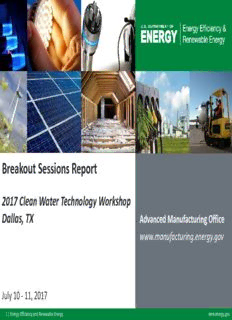
AMO Clean Water Workshop Report Out_July 2017 PDF
Preview AMO Clean Water Workshop Report Out_July 2017
Breakout Sessions Report 2017 Clean Water Technology Workshop Dallas, TX Advanced Manufacturing Office www.manufacturing.energy.gov July 10 - 11, 2017 1| Energy Efficiency and Renewable Energy eere.energy.gov DOE Advanced Manufacturing Office Clean Water Workshop Group 1: Water Purification Breakout Session 1: Membrane-based Technologies Opportunities and Targets • Highly selective membrane (specific ion/contaminant removal, divalent vs. monovalent) • Fouling, scaling resistant • Contaminant resistant (e.g., Chlorine, bromine) • Easily regenerated • Able to be stored dry between deployments • Real-time monitoring / Automatic defect detection • Stable operation in harsh conditions: T, P, chemistry • Catalytic membranes 2 DOE Advanced Manufacturing Office Clean Water Workshop Group 1: Water Purification Breakout Session 1: Membrane-based Technologies Technology Barriers/Challenges • Pilot scale test bed • Selectivity of ions, contaminants (e.g., mono- versus di-valent ions) • Understanding trade-offs in TDS/pathogens/chemicals by application • Overall energy use R&D Needs • Techno-economic consistency (e.g., well-defined metrics: what’s included in energy/cost/… and what is not?) • Brine management • Molecular modeling/Characterization to understand membrane formation and structure • Molecular modeling to understand behavior of water in confined spaces • Characterization to understand membrane formation and structure (Imaging/spectroscopy) • Membranes with tunable selectivity/permeability and responsive to environmental/operating conditions (pH, light, salinity) 3 DOE Advanced Manufacturing Office Clean Water Workshop Group 1: Water Purification Breakout Session 2: Non-Membrane/Thermal Technologies Opportunities and Targets • Electrochemical recovery of valuable components • Scale resistant technologies • Thermal system integration with existing processes (e.g., low grade heat recovery) • 3D printed novel heat exchangers • Reusable materials capable of selective ion removal • Waste nuclear heat utilization for desalination • Metric: kW/mol salt removed 4 DOE Advanced Manufacturing Office Clean Water Workshop Group 1: Water Purification Breakout Session 2: Non-Membrane/Thermal Technologies Technology Barriers/Challenges • Inexpensive material for selective ion removal • Improved scale inhibition • Distributed/modular approaches • Pilot plant access • Ability to efficiently recover low temperature gradient heat • Lack of water and energy metrics R&D Needs • Database of impaired waters and heat sources (Geospatial/amounts/quality) • Hybrid technologies / process intensification • Understanding thermodynamics of high salinity aqueous solutions • Highly selective FO membranes/MD membrane optimization 5 DOE Advanced Manufacturing Office Clean Water Workshop Group 1: Water Purification Breakout Session 3: Pre-treatment Processes Opportunities • Techniques and standards for biofouling potential and treatment • Non-chemical methods of scaling inhibition • Dynamic, reusable flocculants • Selective contaminant removal: photo and electrolytic processes. adsorption • Ability to seasonally adapt: red tide algae bloom, etc. • Low energy micro-particle removal Targets • GIS heat map of injection or evaporation costs • Treatment costs less than costs of disposal • Increase cycles at inland groundwater cooled power plants to >15 • 100% produced water reuse 6 DOE Advanced Manufacturing Office Clean Water Workshop Group 1: Water Purification Breakout Session 3: Pre-treatment Processes Technology Barriers/Challenges • Fundamental understanding of fouling and biofouling, especially biofilms • Removal of biodegradable organics • Real-time sensing and pretreatment response R&D Needs • Biofouling sensing • Tech to market analysis for pretreatment alternatives • Predictive models that include separation, reaction, fluid mechanics, fouling based on complex water source inputs • Membranes stable to pH, temperature, oxidant, and organics • Self-cleaning interfaces • Standardized fouling/scaling potential tests for emerging membrane technologies • Fundamentals of DLVO theory in high ionic solutions and organic carbon 7 DOE Advanced Manufacturing Office Clean Water Workshop Group 2: Water Purification Breakout Session 1: Membrane-based Technologies Targets • Performance (includes efficiency, reliability) • Increased lifetime • Increased stability, robustness • Cost • Moving target, such as $500 acft • Up to 4x system reduction of cost compared to what is currently available • Energy • Up to 3x reduction of electricity use compared to what is currently achievable • Environmental • Up to 2x reduction of greenhouse gas compared to what is currently achievable Technology Barriers/Challenges • Coating technologies for low cost ultrathin membranes with low defect concentration R&D Needs • New materials for CDI (capacity deionization) and MCDI (membrane deionization) including brackish water • Flexibility of material properties tolerant to organics, hydrocarbons, high temperatures, and ions • Better understanding of solute interactions with membranes surface and pores, e.g. ion transport/storage, chemical interactions, interfacing confined spaces and pores 8 DOE Advanced Manufacturing Office Clean Water Workshop Group 2: Water Purification Breakout Session 2: Non-Membrane/Thermal Technologies Targets • 60% of energy is waste heat, what percentage of this is available for 3 year industry payback? • Levelized cost of energy equivalent to grid or less • Mineral recovery as a resource for potentially critical materials Technology Barriers/Challenges • Lack of high profile, field demonstrations that integrate existing technologies and validate to end users deployment • Lack of understanding of evaporation mechanisms at molecular level R&D Needs • New materials and surfaces as well as process optimization to reduce fouling and improve system uptime • High efficiency heat exchangers with long-term, stable performance • Thermally regenerated desiccants, e.g. iconic liquid 9 DOE Advanced Manufacturing Office Clean Water Workshop Group 2: Water Purification Breakout Session 3: Solar-thermal Power/Desalination Integration Targets • Collector cost targets– temperature dependent and capacity dependent • Range was $50 - $100 per m2 • Levelized cost of solar desal must be competitive with conventional methods • Zero liquid discharge • Integrated PV and solar thermal to optimized systems Technology Barriers/Challenges • Scaling/Fouling, especially at high temperature, greater than 300C • Lack of software/optimization tools to guide decision making, especially for small businesses • Lack of understanding of how to cascade system design 10
Description: